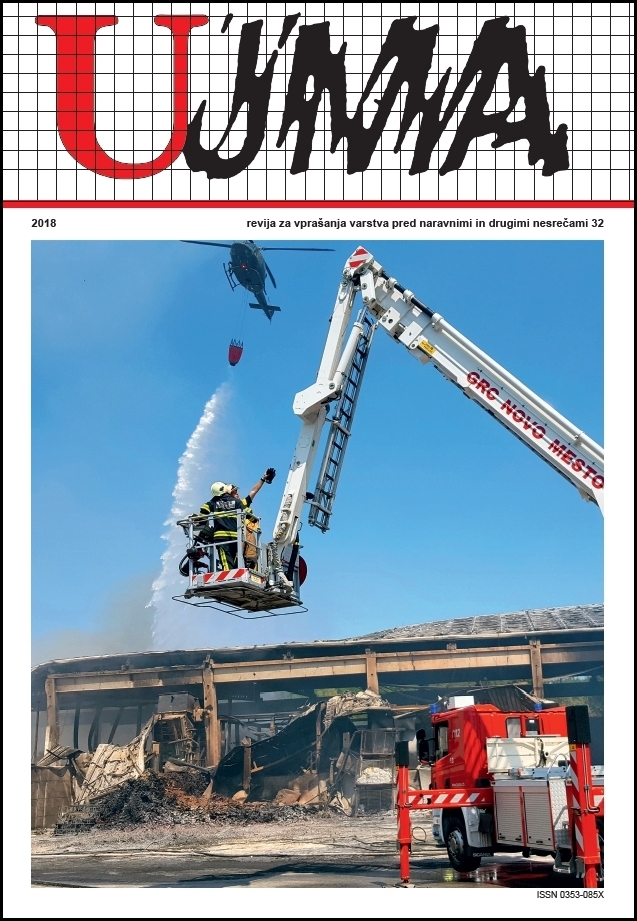ENERGY INDUSTRY EMPLOYEES’ KNOWLEDGE OF FIRST AID MEASURES FOR ELECTRICAL INJURIES
Abstract
Every day, employees in the energy industry are exposed to different injury risk factors. Even though electrical injuries are rare, the consequences can include severe organ damage, high rates of morbidity, or even death. However, these consequences can be prevented or at least mitigated through the appropriate provision of first aid. The data in this study was collected by a survey conducted among the employees of the company Elektro Ljubljana, at the Trbovlje work unit. The survey was completed by 79 out of the 99 employees. The results showed that the employees are well versed in the theory of basic resuscitation techniques and the treatment of burn wounds caused by electricity. However, the questions referring to the combination of injuries and unconsciousness (e.g. unconsciousness due to suspected cervical spine injury), demonstrated that their knowledge is, nonetheless, poor. It was concluded that the knowledge of the employees of Elektro Ljubljana and other companies should be upgraded. First aid training in work organisations should be designed in such a way that the employees gain specific first aid knowledge of injuries and sudden diseases that are more frequent in specific work places, as well as emergency first aid measures.
References
Ahčan, U., 2006. Celostna obravnava opeklinskih poškodb. V: Ahčan. U. (ur.), Prva pomoč: Priročnik s praktičnimi primeri. Ljubljana, Rdeči križ Slovenije, 49–56, 422–4.
Bilban, M., 2003. Prva pomoč v delovnem okolju. Ljubljana, Zavod za varstvo pri delu, d. d., 149.
Cooper, M. A., Price, T. G., 2008. Electrical and lightning injuries. http://lightninginjury.lab.uic.edu/Electr&Ltn.pdf, (20. 2. 2017).
Daley, B. J., Mallat, A. F., 2014. Electrical injuries. MedScape. http://misc.medscape.com/pi/iphone/medscapeapp/html/A433682-business.html <22.8.2017>.
Derganc, M., 1994. Električne poškodbe. V: Mižigoj, M. (ur.), Osnove prve pomoči za vsakogar. Ljubljana, Rdeči križ Slovenije, 242–7.
Dokov, W., 2008. Characteristics of lethal electrical injuries in central and northeastern bulgaria for a 27-year period (1980–2006). Eplasty, 8, 101–5.
Edlich, R. F., Drake, D. B., 2016. Electrical burn injuries: Overview, physics of electrity, low-voltage electric burns. MedScape 1–30. http://emedicine.medscape.com/article/1277496-overview, (22. 8. 2017).
Elektro Ljubljana, 2018. O podjetju. https://www.elektro-ljubljana.si/elektro-ljubljana, (22.11.2017).
Elektro Ljubljana, 2016. Letno poročilo 2016. https://www.elektro-ljubljana.si/Portals/0/LP_ELJ_2016-SLO_1.pdf, (22. 11. 2017)
Gradišek, P., Grenc, M. G., Košir, A. S., et al., 2015. Smernice za oživljanje 2015 Evropskega reanimacijskega sveta. Ljubljana, Slovensko združenje za urgentno medicino, 64–75. http://www.szum.si/, (20. 2. 2017).
Jelnikar, S., Slabe, D., Pirc, M., Brvar, M., 2016. Poznavanje prve pomoči ob zastrupitvi s kemikalijami med zaposlenimi v kemični industriji. Ujma, 30, 188–193.
Karimi, H., Momeni, M., Vasigh, M., 2015. Long term outcome and follow up of electrical injury. J acute dis. 4, (2). 107–11.
Keggenhoff, F., 2006. Nezgode z električnim tokom. V: Bizjak, I. (ur.), Prva pomoč – pomagam prvi! Ljubljana, Prešernova družba, 123–7.
Koumbourlis, A. C., 2002. Electrical injuries. Crit Care Med 33, (11), 424–30.
Lee, R. C., 1997. Injury by electrical forces: pathophysiology, manifestations, and therapy. Curr Probl Surg 34, (9), 681–758.
Lucas, J., 2009. Electrical fatalities in northern Ireland. Ulster Med J 78, (1), 37–42.
Luz, D. P., Millan, L. S., Alessi, M. S., et al., 2009. Electrical burns: a retrospective analysis across a 5 year period. Burns, 35, (7), 1015–9.
The National Institute for Occupational Safety and Health (NIOSH), 2018. Workplace safety and health topics. https://www.cdc.gov/niosh/index.htm, (3. 7. 2018).
Oludiran, O., Innih, K., 2011. Electrical Burn Injury in MidWestern Nigeria . Journal of the West African College of Surgeons.1, (2),18–28.
Ploj, T., 2007. Poškodbe z električnim tokom in električne opekline – pogled internista. V: Gričar, M., Vajd, R. (ur.), Urgentna medicina – izbrana poglavja 2007: zbornik. 14. mednarodni simpozij o urgentni medicini, Portorož, Slovenija 20.–23. 6. 2007. Ljubljana, Slovensko združenje za urgentno medicino, 126–9.
Pogačar, T., Kajfež Bogataj, L., 2017. Obremenjenost slovenskih delavcev z vročinskim stresom. Ujma, 31, 130–131.
Shaha, K. K., Joe, A. E., 2010. Electrocution-related mortality: a retrospective review of 118 deaths in Coimbatore, India, between January 2002 and December 2006. Med Sci Law, 50, 72–74.
Sokhal, A. K., Lodha, K. G., Kumari, M., Paliwal, R., Gothwa, S., 2017. Clinical spectrum of electrical burns – a prospective study from the developing world. Burns 43(1), 182–9.
Švigelj, V., 2008. Nezavest. V: Ahčan, U., Slabe, D., Šutanovac, R. (ur.), Prva pomoč priročnik za bolničarje. Ljubljana, Rdeči križ Slovenije, 38–40.
Taylor, A. J., McGwin Jr, G., Valent, F., Rue III L. W., 2002. Fatal occupational electrocutions in the United States. Inj Prev 8,(4), 306–12.
Young, D. M., 2006. Burn and electrical injury. In: Mathes, S. (ur.), Plastic Surgery. Philadelphia, Saunders Elsevier, 831.
Zbuchea, A., 2015. Humeral neck fracture after electrocution – case report and literature review. Chirurgia 110, (5), 491–3.
Downloads
Published
Issue
Section
License

This work is licensed under a Creative Commons Attribution-NonCommercial-NoDerivatives 4.0 International License.
The articles are made available to the public under Creative Commons Attribution-NonCommercial-NoDerivatives 4.0 International (CC BY-NC-ND 4.0).


